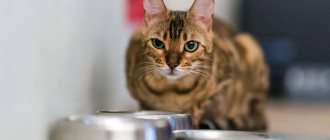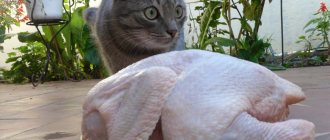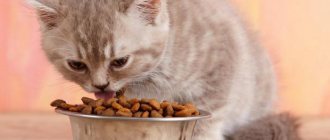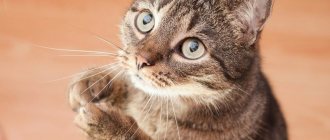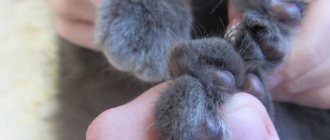Distemper in cats is a very serious disease that is fatal in 90% of cases. Another name for the disease is viral enteritis or panleukopenia. It is worth considering that the virus that causes distemper in cats is adapted to any negative influences. It is not afraid of the following factors: heating to a temperature of 60 degrees, freezing, disinfection. The virus has the unique ability to live in the external environment for a year.
Routes of infection
There are several factors that cause distemper infection in cats. The main path is contact. That is, when interacting with a sick animal. Moreover, the proximity of the contact does not matter. A cat can become infected by walking on the grass or eating food from an infected person’s bowl. This is because high concentrations of the virus are found in the cat's stool, nasal discharge or saliva. Consequently, any discharge into the outside world puts all cats without exception at risk of infection.
- Airborne droplets - when near a sick cat.
- Through parasites and insects: fleas, ticks.
- Through a person, the virus can enter the house on the clothes or shoes of any family member. No one is immune from the disease, so you should not ignore the protection of your pet, even if he lives only within the confines of the house without going outside.
It should be borne in mind that after recovery the animal remains a carrier of the disease for some time.
An unpleasant fact: in the house where the sick animal was, the virus is stored for 6 to 12 months. Therefore, during this time you should not get a new pet.
There is a high probability of infection with distemper in cats with weakened immune systems, after illness or stress. Adult cats are most often exposed to infection: their defenses are depleted, and the body cannot resist the penetration of viruses and infections. That is, the main risk group for infection with distemper in cats is animals aged 6 years and kittens up to one year. Moreover, the younger the cat, the less chance of survival. In case of intrauterine infection, kittens are doomed to death. There are certainly chances to survive. But most often kittens are born with defects.
Attention: this disease is unique to cats. The FFV virus does not attack humans or dogs.
The period of greatest activity of the virus occurs in the spring months. At this time, the pet owner should be extremely careful.
Treatment of feline distemper
Specific treatment for plague has not been developed. The goal of therapy is to eliminate intoxication, replenish the water-salt balance, stop vomiting and improve intestinal function. The first thing to do is to provide the cat with peace. It is placed in a separate room, where there is no draft and bright light. The air temperature should be within +20…+24 ºС. Having discovered symptoms of distemper, the cat is immediately isolated from other pets. She shouldn't be allowed outside.
Medicines for the treatment of panleukopenia:
- immunostimulants – Cycloferon, Anandin;
- antiviral agent – Fosprenil in a dosage of 0.2–0.5 ml (depending on the weight of the pet) 4 times a day;
- antibiotics intramuscularly, protecting the pet from bacterial infection - Ampicillin, Caritsef or their analogues;
- sulfonamide drugs are administered subcutaneously or into the muscle - Norsulfazole, Enteroseptol, Sulfadimethoxine;
- parenteral vitamins – ascorbic acid, B1, B2, B6 and B12;
- to restore water balance, a glucose or Ringer solution or saline solution is injected under the withers 5-6 times a day, 20-50 ml;
- antiemetics - Metoclopramide, Ondansetron or analogues;
- antispasmodics – No-shpa, Dibazol;
- probiotics – Bifidumbacterin, Lactobifid.
Cycloferon
If a cat has inflamed eyes or a runny nose, which often happens with viral enteritis, the owner of the animal must remove the discharge. The procedure is carried out several times a day using sponges soaked in chamomile decoction or chlorhexidine solution.
The course of treatment for plague is 7–14 days. If therapy is started in a timely manner, improvement in the animal’s condition is observed within 3–4 days.
Diet for a sick cat
In the first 2 days of illness, the pet will not want to eat, so there is no need to offer it food. A bowl of warm boiled water is placed next to the bed. You can add a little chamomile decoction to it. When he feels better, you can start feeding him small portions several times a day.
On day 3, the cat is given a low-fat chicken breast or beef broth to drink. If there is no gag reflex, it is recommended to prepare thin porridge from oatmeal or rice. Feeding is done 5-6 times a day. The pet should eat no more than 20 g of food at a time. On the 4th or 5th day, you can add steamed minced meat from lean fish, veal or poultry fillet to the porridge - 10 g of meat per 100 g of boiled cereal.
If the pet eats willingly and no longer vomits, the volume of portions can be gradually increased. Next, a boiled quail egg is introduced into the diet. On days 6–7, it is allowed to switch the animal to premium canned diet food.
The effect of the virus in the cat's body
Having penetrated the body, the virus chooses blood as its initial target. As a result, the number of white blood cells drops sharply. Lack of therapy leads to progression of the disease. As a result, the functioning of the gastrointestinal tract, cardiovascular system, lungs and bone marrow, as well as lymphoid tissues is disrupted. After a certain period of time, the nervous system is affected. Causes leading to death: severe dehydration, heart failure, secondary infections that develop against the background of the disease.
Effect of ethanol
There is a myth that ethanol is a natural metabolite. It is not true. There is not a single reaction that occurs inside a living organism that would result in the production of ethanol. At the same time, there are many bacteria in the intestines whose task is to produce vitamins, process fiber, and some of them produce ethanol (about 3 grams per day). However, there are no such microbes inside the cat’s intestines; they exist only in the gastrointestinal tract of humans and other omnivores and herbivores.
Ethanol is a neurotoxic poison, a carcinogen and a drug that suppresses the activity of the central nervous system. Suppression of the nervous system is possible up to coma and death. The lethal dose is 5-8 ml of alcohol per kilogram of weight, that is, for a cat this is about 3-4 tablespoons of 40% vodka (it contains 20 ml) or teaspoons of pure ethanol.
Stages of intoxication with increasing dose
When consuming small doses, the “reward system” is activated, the active substance of which is dopamine. The purpose of these reactions is to motivate the animal to perform certain actions: sex, successful hunting, victory over an opponent in a territorial fight. However, you should not think that you can give your cat alcohol to “relax” it, since the “useful” dose is too small - literally 0.1 ml of ethanol or 0.3 ml of vodka. It is inconvenient to administer such an amount of alcohol even through a syringe.
A further increase in the dose depresses the activity of the central nervous system; every person has seen all these aspects more than once or even experienced it on himself:
- the brain’s ability to concentrate on various thoughts decreases, only one idea remains (usually not a good one);
- coordination of movements is impaired;
- the hunger center is stimulated, that is, the animal’s appetite increases;
- the last stage is narcotic dreamless sleep.
Sobering up
It begins simultaneously with intoxication, but since this process is slow, its result is felt only after stopping drinking alcohol.
Sobering up is directly related to the destruction of ethanol.
It goes in 2 stages:
- Decomposition of ethanol to acetaldehyde . Several systems in the body are responsible for this; the transformation of alcohol occurs both inside cells and in the blood, liver and intercellular fluid.
- Decomposition to acetic acid . This stage of decomposition takes place exclusively inside the cells, which is why the speed of this stage is greatly inhibited.
It is acetaldehyde that is the main cause of all the unpleasant sensations of a hangover. Moreover, the second stage takes much longer than the first. As a result, due to the difference in speed, acetaldehyde accumulates, which is not destroyed immediately, resulting in a hangover.
Is it possible to give meat to a cat?
Is it possible to give liver to a domestic cat?
Can cats have chicken liver?
Symptoms of distemper in cats
Having penetrated the body, the virus quickly damages organs and tissues. The incubation period is 7 days in adults; in babies, characteristic signs appear within a couple of days.
In order to save the animal, you need to quickly notice the symptoms of distemper in a cat and start treatment in a timely manner. In advanced forms, drug intervention will not help, and the cat faces death. Distemper in cats is divided into three types: fulminant, acute, and subacute. Depending on the type of panleukopenia, signs of the presence of the virus in the body may vary.
Treatment of plague
Every free-ranging cat can become infected with panleukopenia at any time. Popularly, this disease is most often called “distemper”, and there is no cure for it yet. The disease very quickly affects the entire body of the animal, and a person is ready to try any means to save his beloved pet.
Symptoms of the disease. Distemper is very easy to recognize by its external signs. A sick animal begins to refuse food and water, hide from humans and have difficulty breathing. After a couple of days, obvious symptoms appear:
- very liquid green feces;
- purulent discharge from the nose;
- conjunctivitis;
- sticky wool;
- fever;
- inflamed lymph nodes.
Vodka therapy. Feline distemper is treated with vodka in 2 ways:
- Vodka or moonshine is diluted in half with water and given to the animal 5 ml per day. The effect of this treatment is visible within the next day. After a few days the pet recovers completely.
- Beat a chicken egg with 20 g of vodka and give it to the cat twice a day.
It is better to start treatment immediately if panleukopenia is suspected.
Once blood appears in the stool and vomit, the animal is likely to die.
Lightning form
This type is typical for young pets from 2 weeks old. First of all, weakness and drowsiness appear, and the condition becomes more complicated every day. The peak becomes fever and complete disregard for food. The owner will notice an unhealthy appearance of the fur: it loses its shine and fluffiness, and becomes sticky. Over time, the virus strengthens in the body and affects the nervous system. The cat's behavior becomes inappropriate: it can rush around the apartment or hide in secluded corners. Light and harsh sounds are irritating. The owner may think that the animal has rabies. This is why timely diagnosis by a doctor is necessary, because it is difficult for a person without the appropriate education to distinguish between diseases with similar symptoms. Motor activity is reduced to zero. The animal can spend the entire day lying down. If treatment is not started immediately, more severe symptoms of distemper in cats will appear: diarrhea with blood clots and vomiting with foam.
Helpful information: Kitten distemper is fatal in most cases, and symptoms do not necessarily have to be present. A weak immune system is unable to resist the virus.
Forms of plague
Diagnosis of plague is carried out in the laboratory, but the disease can also be identified by its characteristic symptoms. Plague is divided into three forms.
- Lightning fast (super acute). Signs of distemper in kittens in most cases are attributed to the fulminant form of infection. It progresses very quickly, 8 out of 10 kittens die within a week.
- Spicy. Adult cats are susceptible to it. Animals from 6 years of age are at risk, when the immune system begins to work worse.
- Subacute. The vaccination given to prevent distemper does not always work. But if the virus enters the body of a cat that has undergone antiviral vaccination, the disease passes easily. With this form of the disease, a cat can get distemper at home.
Acute form
In most cases it affects adults.
First signs:
- Decreased or lack of appetite;
- Drowsy depressed consciousness;
- Lack of desire to move and be active;
- Diarrhea and vomiting are yellow or green in color, after a while bloody clots appear;
- Temperature fluctuations: drops or rises;
- Complications of the cardiovascular system: cough, wheezing;
- Atypical discharge from the eyes and nose;
- The appearance of ulcers and redness on the skin;
- Increased dehydration.
If even a few symptoms appear, you should immediately go to the doctor. In rare cases, the animal is able to cope on its own. Most often, without the necessary course of treatment, the cat is doomed to death. But if it is possible to cure distemper in cats, then the animal has protection from re-infection for the coming years, and maybe even for life.
How does panleukopenia manifest in cats?
It goes by pretty quickly. Distemper disease and symptoms have several different types:
- Subacute;
- Spicy;
- Super sharp or lightning fast.
As a rule, distemper develops at lightning speed in young cats. Mostly in animals, symptoms are expressed in weakness:
- The animal’s body begins to tremble, and the cat itself refuses to drink and eat.
- The cat's fur instantly becomes matted and dirty.
- If the virus has penetrated the nervous system, the cat begins to rush around, it is afraid of the light and hides.
- There is a feeling that the animal has become rabid.
- Without reacting to any stimuli, the cat is almost constantly lying down.
These are the first signs of the appearance of plague. In chronic cases in cats, the disease may cause foul-smelling, bloody diarrhea and yellow foam vomiting. The fulminant form of the disease requires a quick visit to the veterinarian within one to two hours.
Acute distemper in cats is typical for adult animals. At the initial stage, the cat does not eat anything, lies almost constantly and does not react to the outside world. Light-colored diarrhea and green or yellow vomit appear. After a few days, vomiting may include bloody discharge.
If the disease creates complications on the cardiovascular system, then wheezing in the chest and a dry cough appear. The animal breathes with its mouth open. There may be discharge from the eyes and nose. Moreover, the nose becomes hot and the eyes are red. Purple spots and often purulent areas form on the skin. The cat is very thirsty, but will not be able to quench it due to spasms in the throat.
It is almost impossible to get over distemper at home, without going to a veterinarian. But if a miracle does happen, then the cat develops immunity. If the pet lasts 3-4 days, then the chances of recovery are quite high. There are frequent cases when distemper is asymptomatic and the animal dies within 2–3 days. Therefore, you should not expect a miraculous healing, but immediately turn to a veterinarian for help.
The subacute form of this disease is typical for adult animals with strong immunity, as well as sometimes for vaccinated cats and for older clinically healthy animals. Although there may be exceptions to all rules.
In the subacute form, the disease in cats lasts 1–3 weeks. Moreover, the signs of the disease are not so pronounced, and the percentage of a positive outcome - recovery - is quite large.
Treatment
It is strictly forbidden to try to cure your pet on your own. This is fraught with serious complications and the transition of the disease to a more serious stage. Only a doctor can prescribe a competent course of treatment after a thorough examination and test results. Having established the exact form of distemper in a cat, therapy will be prescribed that will lead the animal to recovery. There is no single course of treatment or any miracle cure for the disease; the doctor builds therapy based on the data of a particular animal.
The basis of treatment is:
- Drugs that maintain water-salt balance at an optimal level;
- Vitamins and glucose to strengthen the immune system;
- Antibiotics and antivirals;
- Painkillers and antiemetics.
Average duration of treatment: 1-2 weeks. The duration depends on the health status of the particular pet and the severity of the disease. Under no circumstances should you stop therapy without a doctor’s examination, even if it seems that the virus has been defeated. The end of the course of treatment is possible after re-diagnosis at the veterinary clinic. Otherwise, an animal that is not completely cured may catch the virus again, and the disease will begin in a new circle.
Treatment of frostbite
In cold winter, a cat can get frostbite on its nose, ears, paws, and tail. It is necessary to immediately provide assistance if your pet shows signs of frostbite :
- swelling and compaction;
- pale skin;
- swelling and blistering (severe frostbite).
If a cat notices these symptoms, it should be wrapped up and taken to a warm room. Vodka for treating cats with frostbite is a surefire remedy. Frostbitten areas are washed with soap and water and treated with vodka (alcohol or cologne). It is recommended to warm up gradually, pouring water, starting at 18-20°C and gradually increasing the temperature, bringing it to 38-40°C. It is recommended to massage the affected areas during warming. After normalizing the blood flow in the vessels, wipe again with vodka or alcohol.
If it is not possible to go indoors, warm up the frozen animal with your warmth, rubbing the frozen parts of the body with your hands and hiding the cat under your jacket. Do not rub with snow under any circumstances. This will only make things worse.
Useful tips for a cat owner
If only a veterinarian can prescribe treatment, then every pet owner can create favorable conditions conducive to a speedy recovery.
- Regular ventilation. Do not leave the animal in a draft. During the ventilation period, it is advisable to take the cat into the next room.
- The room in which the cat is located must be darkened. It is advisable to protect her from loud sounds.
- Timely cleaning of the tray. Moreover, the main thing is not to forget about the personal hygiene of all family members, especially after cleaning up feces. Discharge from the eyes must be removed immediately with a cotton swab.
- A careful diet. During the treatment period, you need to monitor your pet’s diet. The food offered to the cat should be at room temperature and ground. In the first days, it is recommended to feed fermented milk products and low-fat broth.
- Detailed disinfection of the premises is necessary. To do this, it is best to use a solution of bleach in a ratio of 1:9 to water. Moreover, the walls, floor, and all secluded places should be treated. Particular attention should be paid to personal hygiene items.
Attention: There is no need to encourage your cat to eat. Over time, the appetite will improve and the animal will return to its usual diet. Recommended dosage: several times a day in small portions. Veterinarians advise sticking to the diet for three months after complete recovery. This is necessary in order to set up the normal functioning of the gastrointestinal tract. For 2-3 months after complete recovery, you should not include greens, cereals and vegetables in the cat’s menu.
How to care for a cat during distemper and what to feed it
Proper care is required during the treatment process. Errors at this stage can reduce all the results of therapy to zero. The cat should be in a warm, dry room without drafts. Bright light will cause discomfort to sore eyes. A sick animal needs twilight.
The water in the drinking bowl should be boiled at room temperature. It is allowed to add a decoction of chamomile and calendula to the water. Change the water 3 times a day.
The animal should be fed warm beef broth. As soon as the condition improves, rice and buckwheat porridge are introduced into the diet. A week later, in the absence of diarrhea and vomiting, the pet is given lean cottage cheese and chopped lean meat. You need to feed 6 times a day in small portions. There is no need to force a cat to eat.
Important! The animal should not be allowed out for walks during treatment and for another 4 months after recovery.
Treating distemper in a cat at home
Many people are in no hurry to seek qualified help when the first symptoms of distemper appear in cats. Everyone wants to cure their pet as soon as possible without drug intervention. Numerous reviews and advice from experienced cat owners indicate that treatment of this disease with folk remedies is possible. They claim that vodka will help cope with distemper in cats. Proven recipe: 1 tablespoon of vodka is mixed with the yolk until a homogeneous consistency is formed. Recommended dose: 1 tablespoon three times a day. If you decide to start treatment with vodka, you should understand that you can expect a positive result in the case of a mild form of distemper in cats or in the first days of infection, when the virus has not had time to spread to organs and tissues.
Remember: your pet's life is at stake. Is it worth ignoring the help of qualified specialists in order to try a folk recipe? After all, in this case no one gives any guarantee of recovery.
What are useful recipes used for?
For indoor use
This remedy helps with the appearance of signs of distemper - discharge from the nose and eyes of an animal.
If cats are poisoned, give them a solution of vodka. The component is combined with water in a 1:1 ratio and the pet is given 1 tablespoon of the resulting composition. However, vodka is most often used to treat cats from panleukopenia, the so-called distemper. The pathology is a viral infection that can affect all organs within a few days. Manifested by the following symptoms:
- diarrhea;
- vomit;
- cardiopalmus;
- weakness;
- loss of appetite;
- lymph nodes increased in size;
- copious discharge from the visual organs and nose;
- the appearance of purulent wounds on the skin.
There is no known cure for this disease. Animals suffer for a long time and die helplessly in front of their owners. And only if you add alcohol, you can save the cat. You should drink vodka once a day, 1 tsp. Positive results in the well-being of kittens are observed within a day. There is another recipe with an egg:
- Take 20 ml of vodka or 10 ml of diluted alcohol.
- Break the egg and separate the yolk.
- Mix it with liquid.
- Give to kittens or older animals 2 times a day.
Pets drink this mixture much better. After using the product, there is no need to feed the cat fermented milk products for several days, since the yolk neutralizes the toxic properties of alcohol.
Recipe for helminthic infestation
This remedy will help your pet get rid of internal parasites in a few days.
Worms found in kittens can also be treated with vodka. Veterinarians warn: if an animal drinks alcohol, which is very quickly absorbed into the stomach and intestines, parasite poisoning occurs. Give 0.5 tsp. 2 times a day for 3 days. After this time, the cat must be rehabilitated. If the animal drinks milk, it should be given a drink for several days. In case of milk intolerance, as, for example, in a British cat, you can offer some other fermented milk product. As a rule, no trace remains of the disease.
Vodka for external use
Vodka is also successfully used for frostbite. If during severe frosts the kitten's ears, nose, paws or tail are frozen, then you should bring the pet into a warm room and begin treatment. First, you need to wash the affected areas with soap and water and gently wipe with vodka. You can also resort to using moonshine. If the cat has frostbitten limbs, then apply a bandage with cotton wool soaked in alcoholic liquid.
Sometimes your pet can get hurt. First of all, you should stop the bleeding using hydrogen peroxide, and then treat the skin around the wound with vodka. Next you should apply a bandage. If the wound is minor, you can continue to treat it at home. Otherwise, you need to contact a veterinarian who will provide professional assistance.
The possibility of burns is also possible for domestic miscreants. Most often, assistance must be provided at home. To calm the animal, you need to give it 0.5 large spoon of vodka. Then the burned area should be kept in cold water for 10 minutes. Then treat the burn with alcohol or fish oil. Nursing cats are often susceptible to mastitis. For this disease, alcohol or vodka compresses are made. You will need to moisten a gauze swab in an alcohol-containing liquid and apply it to the sore spot. The procedure should be repeated until the hardening disappears.
Preventive measures against infection
If a person owns several cats and one of them has been diagnosed with distemper, then the rest should be urgently isolated. After this, it is recommended to wait for the incubation period, about three weeks to be on the safe side, and vaccinate all cats. Every owner should understand that it is impossible to completely eliminate the possibility of infection of a pet. However, regular vaccinations can protect your pet from serious illness. That is, it will minimize the risk of infection. Today there are vaccines whose action is aimed at stimulating immunity. They are absolutely safe for the health of the animal.
Useful information: cats that have reached adulthood need vaccination once a year. Before the procedure, deworming and confidence in the pet’s health are necessary. There is a list of contraindications due to which vaccination can only cause harm: pregnancy, lactation, weakened immunity, teething.
Kittens are ready for vaccination 9 weeks after birth, but revaccination is mandatory after 21 days. It is important to understand that vaccination must be regular. The following vaccines are trusted: Nobivak, Quadrikat, Multifel.
Consequences after the disease
Successful recovery does not guarantee that the animal will not have health problems in the future. After an illness, there is a high probability of developing chronic inflammation of internal organs and systems. However, it’s up to the cat’s owner to do everything, because it’s possible to prevent the problem with three simple steps:
- Timely vaccination;
- Preventive examination at a veterinary clinic, especially if any symptoms are observed;
- Careful care for your pet: good nutrition and comfortable living conditions.
